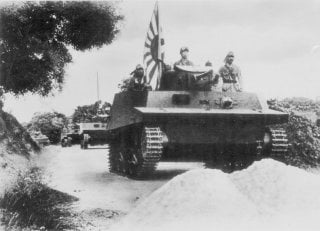The Japanese Were One of the First to Develop a Floating Tank
Most of the Japanese amphibious tanks were destroyed during the war while surviving examples were typically left abandoned across the Pacific.
When the British military first developed tanks during World War I, it was under the “Landship Committee” and originally these were envisioned as massive vehicles that would weigh three hundred tons and roll over any terrain. In the end, the decision was made to go with a smaller vehicle, but fast forward a decade and the Japanese military saw a need for a tank that truly was part-ship.
The Type 2 Ka-Mi predated Allied efforts including the DD tanks developed by British Major-General Sir Percy Hobart, which were fitted with the Duplex Drive that allowed the modified M-4 Sherman tanks to “swim” to shore on D-Day.
The Japanese Navy’s Tank
What is also notable about the Type 2 Ka-Mi is that it was developed by Japan’s navy a year before the attack on Pearl Harbor.
As the Japanese Imperial Army (IJA) and Japanese Imperial Navy (IJN) had what can only be described as one of the most notorious inter-service rivalries of the twentieth century. It was one of mutual distrust and arguably hindered Japan’s war effort, to the point that each service developed its own weapons.
In the late 1920s that led to the IJA’s development of the Sumida Amphibious Car (AMP), the Type 1 “Mi-Sha,” the SR-II Ro-Go and the Ishikawajima Amphibian. Such a vehicle was seen as critical for a war that was expected to take part across the Pacific Ocean, but the IJA had other priorities and failed to refine the concept. Moreover, the inter-service rivalry was such that the IJN took over the development of amphibious vehicles in 1940 and worked with Mitsubishi to modify the Type 95 Ha-Go light tank, which was used by both the Army and Navy.
The project evolved from the Type 1 Floating Tank Ka-Mi, which led to the development of the newly designed Type 2 Ka-Mi. It was devised specifically for the Imperial Navy’s Special Naval Landing Forces for assaulting the small Pacific islands that were largely devoid of pontoons or harbor facilities. The design was finalized in 1941 and production began in 1942.
The Type 2 Ka-Mi took the basic Type 95 Ha-Go light tank and welded a hull with rubber seals in place of riveted armor to make it water-light. The hollow pontoons, made of steel, at the front and back of the tank gave it the necessary buoyancy. The front pontoon was divided into eight compartments, which was meant to reduce flooding if hit by enemy fire. The pontoons could also be jettisoned from inside after the tank made it to shore.
The engine transmission was also heavily modified to power the shafts—which provided a six-knot speed on the water while steering was provided by a pair of rudders that were operated via cables running from the driver’s compartment. On land, the tank was capable of a maximum speed of twenty miles per hour.
The Type 2 Ka-Mi weighed 12.3 tons with the pontoons and actually was fairly low in the water, which likely helped protect it from enemy fire. It reportedly performed quite admirably in the water, but the problem was that the pontoons were no substitute for actual armor and the amphibious tank was no match for Allied weapons. It was effective against an easy, slow-moving target for 37-millimeter antitank guns or even American bazookas.
It was also lightly armed with just a 37-millimeter Type 1 high-velocity gun in the turret along with a Type 97 light machine gun as its secondary armament. A second Type 97 machine gun was also located in the tank’s bow.
Like other Axis weapons, it arrived simply too late for its intended purpose to be used in assaults of Allied-held islands. Instead many of the 182 or so Type 2 Ka-Mi tanks that were produced were assigned to naval garrison detachments. Most of the Japanese amphibious tanks were destroyed during the war while surviving examples were typically left abandoned across the Pacific. The Kubinka Tank Museum in Moscow has the only complete tank on display today.
Peter Suciu is a Michigan-based writer who has contributed to more than four dozen magazines, newspapers and websites. He is the author of several books on military headgear including A Gallery of Military Headdress, which is available on Amazon.com.
Image: Wikimedia Commons

